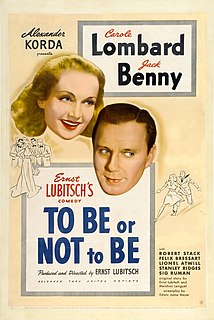
To Be or Not to Be is a 1942 American black comedy film directed by Ernst Lubitsch and starring Carole Lombard, Jack Benny, Robert Stack, Felix Bressart, Lionel Atwill, Stanley Ridges and Sig Ruman. The plot concerns a troupe of actors in Nazi-occupied Warsaw who use their abilities at disguise and acting to fool the occupying troops. It was adapted by Lubitsch (uncredited) and Edwin Justus Mayer from the story by Melchior Lengyel. The film was released one month after actress Carole Lombard was killed in an airplane crash. In 1996, it was selected for preservation in the United States National Film Registry by the Library of Congress as being "culturally, historically, or aesthetically significant."

Ehrhardt is a town in Bamberg County, South Carolina, United States. As of the 2010 census, the town population was 545.

The Kapp Putsch, also known as the Kapp–Lüttwitz Putsch, named after its leaders Wolfgang Kapp and Walther von Lüttwitz, was an attempted coup against the German national government in Berlin on 13 March 1920. Its goal was to undo the German Revolution of 1918–1919, overthrow the Weimar Republic, and establish an autocratic government in its place. It was supported by parts of the Reichswehr, as well as nationalist and monarchist factions.

The Marinebrigade Ehrhardt was a Free Corps (Freikorps) group of around 6,000 men formed by Captain (Korvettenkapitän) Hermann Ehrhardt in the aftermath of World War I, also known as II Marine Brigade or the Ehrhardt Brigade. It took part in the fighting for the cities of central Germany and the northwestern ports, in addition to participating in the Kapp Putsch.
Helmuth Ehrhardt was a German psychiatrist.

Hermann Ehrhardt was a German Freikorps commander during the period of turmoil in Weimar Republic Germany from 1918 to 1920, he commanded the famous II.Marine Brigade, better known as the Ehrhardt Brigade or Marinebrigade Ehrhardt.
The Automobilwerk Eisenach (AWE) was an automobile manufacturer in Eisenach, Germany.
Ehrhardt is Old High German for "Ehre" = honour and "hard" = strong. It may refer to:
Organisation Consul (O.C.) was an ultra-nationalist, antisemitic and anticommunist terrorist organization active in Germany from 1920 to 1922. It was formed by members of the Marinebrigade Ehrhardt, a Freikorps unit which disbanded after the Kapp Putsch failed to overthrow the German Weimar Republic in March 1920. It was responsible for the assassinations of the Republic's Minister of Finance Matthias Erzberger on 26 August 1921 and German-Jewish Foreign Minister Walther Rathenau on 24 June 1922. In response to Rathenau's murder, the "Law for the Protection of the Republic" (Republikschutzgesetz) was enacted by the Reichstag, resulting in the banning of the O.C. on 21 July 1922. The O.C. assassinated at least 354 people.
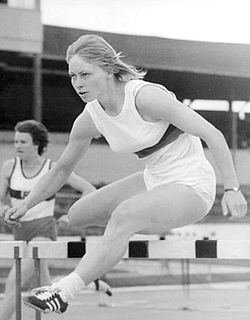
Annelie Ehrhardt, is a retired German hurdler. She won the gold medal in the inaugural 100 metre hurdles event at the 1972 Summer Olympics held in Munich, Germany, setting a new world record, and becoming the first East German Olympic Champion in this event. She also won a silver medal at the 1971 European Championships and a gold medal at the 1974 European Championships in a new championship record of 12.66 seconds.
The Ehrhardt was a German automobile manufactured from 1905 until 1924. The company was founded by Gustav Ehrhard, son of Heinrich Ehrhardt of Dixi. Its operations were centered at Zella-St-Blasii and at Düsseldorf. Ehrhardts came in two- and four-cylinder models of high quality and price. The largest was a 7956cc four-cylinder which had four-wheel brakes by 1913. After 1918, the factory produced a 40hp four-cylinder and a 55hp six-cylinder, both luxury cars with ohc engines.
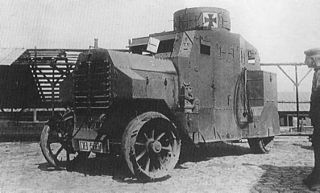
The E-V/4 Panzerkraftwagen Ehrhardt was one of the first examples of a type of high and flatsided armoured car design that the Germans used almost until the start of the Second World War for internal policing duties. It weighed nearly 9 tons, had a crew of eight or nine, and carried an armament of up to three machine-guns.
Karl Ehrhardt was one of the New York Mets' most visible fans and an icon at Shea Stadium from its opening in 1964 through 1981. Known as the "Sign Man," Ehrhardt held up 20-by-26-inch black cardboard signs with sayings in big white upper-cased paper characters that reflected the Mets' performance on the field, and echoed the fans' sentiments off of it. He usually brought a portfolio holding about sixty of his 1,200 signs to the stadium, each of them with color-coded file tabs for different situations. He was always positioned in the field-level box seats on the third base side, wearing a black derby with a royal-blue-and-orange band around the bottom of the crown and the primary Mets logo on the front. Ehrhardt wasn't afraid to criticize the team's front office, once holding up a sign that said "WELCOME TO GRANT'S TOMB", referring to the team's miserable play and M. Donald Grant, the team's chairman of the board.
Erhardt is a surname, and may refer to:
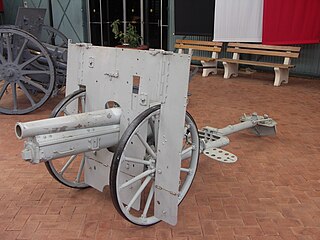
The Ehrhardt 7.5 cm Model 1904 mountain guns were originally issued to the Schutztruppe in German South-West Africa. The gun was also issued to the Portuguese colonial forces in Angola.
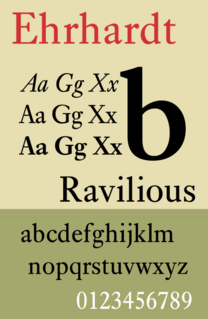
Ehrhardt is an old-style serif typeface released by the British branch of the Monotype Corporation in 1938. Ehrhardt is a modern adaptation of printing types of "stout Dutch character" from the Dutch Baroque tradition sold by the Ehrhardt foundry in Leipzig. These were cut by the Hungarian-Transylvanian pastor and punchcutter Miklós (Nicholas) Tótfalusi Kis while in Amsterdam in the period from 1680 to 1689.
Heinrich Ehrhardt was a German inventor, industrialist and entrepreneur.

German submarine U-1016 was a Type VIIC/41 U-boat of Nazi Germany's Kriegsmarine during World War II.
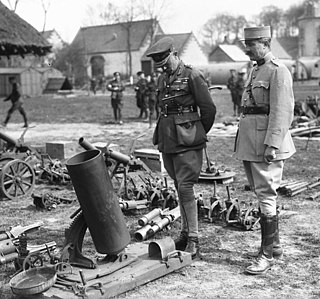
The 24 cm schwerer LadungsWerfer Ehrhardt shortened to 24 cm sLW Ehrhardt, or (24 cm Heavy Charge Thrower Ehrhardt) in English was a heavy mortar used by the Imperial German Army during the First World War.








